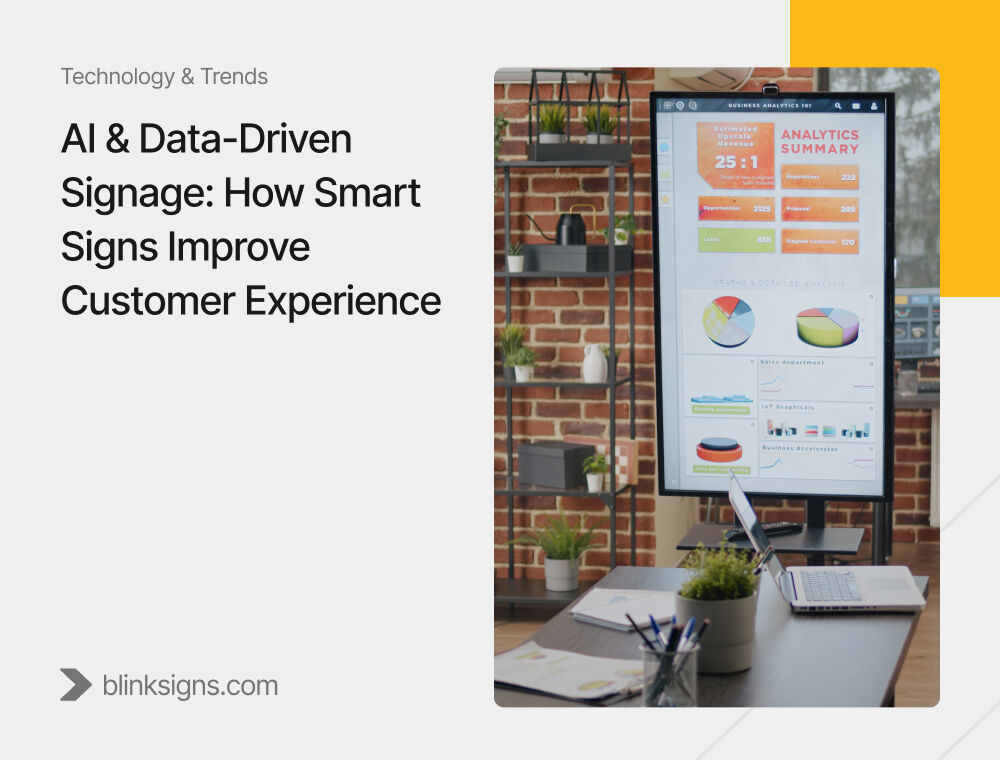
AI & Data-Driven Signage: How Smart Signs Improve Customer Experience
When Traditional Signage Isn’t Enough Anymore
Business owners and facility managers are under pressure to deliver better customer experiences across every touchpoint, without increasing headcount or marketing spend. One area often overlooked is signage. Most brands still rely on static displays that never adapt, never measure results, and never speak directly to the person viewing them.
Meanwhile, competitors are using AI-powered signage systems to make their locations more responsive, more engaging, and more efficient. They’re delivering real-time updates, changing messages based on foot traffic, and capturing customer behavior insights—without extra manual work.
This shift isn’t about technology for technology’s sake. It’s a response to changing expectations. Whether someone is walking into a retail store, navigating a hospital campus, or ordering at a quick-service restaurant, they want signage that feels clear, intuitive, and relevant.
At BlinkSigns, we work with companies that are ready to evolve their signage from a static visual to a smarter experience layer. Using AI, machine learning, IoT sensors, and real-time data, we help transform screens into intelligent brand touchpoints—ones that respond, adapt, and inform.
What Is AI-Powered Signage and Why It Matters
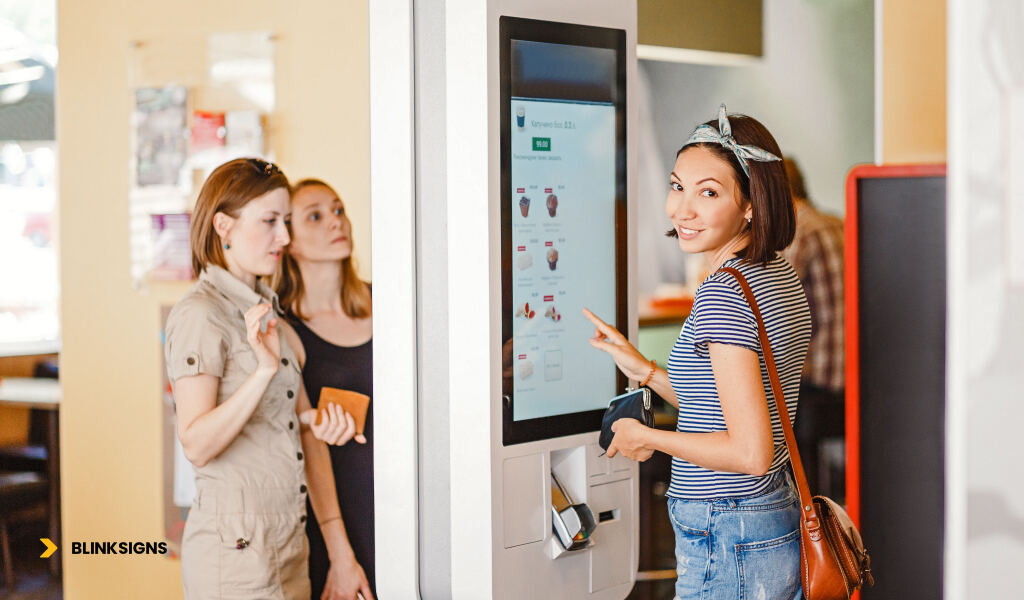
Digital signage used by customers
AI-powered signage combines digital displays with intelligent technology that analyzes customer behavior, adjusts content dynamically, and delivers insights in real time. Think of it as your on-site customer engagement engine, always learning, always optimizing.
Key Technologies Behind Smart Signage
- Artificial Intelligence (AI): Enables pattern recognition and predictive behavior modeling
- Machine Learning (ML): Continuously improves content delivery based on user interaction data
- IoT Sensors: Track foot traffic, temperature, and motion to trigger content changes
- Facial Detection & Computer Vision: Detect viewer demographics for personalized targeting
- Cloud-Based CMS: Allows remote, real-time content scheduling across multiple locations
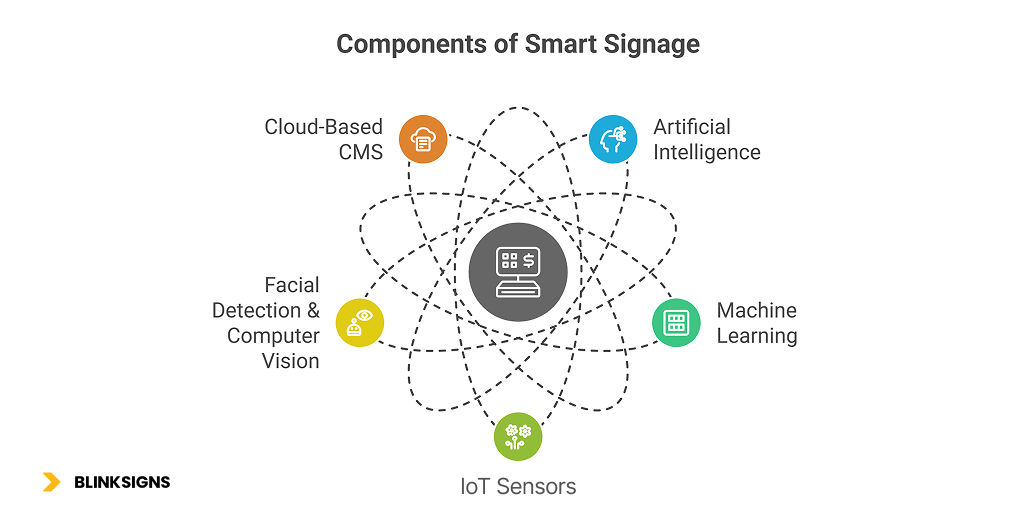
Key Technologies Behind Smart Signage
This isn’t about gimmicks—it’s about relevance. Smart signage makes every message count, adjusting visuals based on time of day, location, inventory, or even the mood of your customers.
Why Businesses Are Making the Shift
- Increased engagement from context-aware content
- Real-time performance analytics to guide marketing decisions
- Higher ROI on digital campaigns through behavior-based targeting
- Omnichannel integration with CRM, POS, and mobile apps
- Future-proofing customer experience in an AI-first era
BlinkSigns works with companies that don’t want their signage to fall behind evolving expectations. We offer the tools—and the expertise—to help brands transition from static messages to living, breathing customer touchpoints.
How Smart Signage Enhances Customer Experience
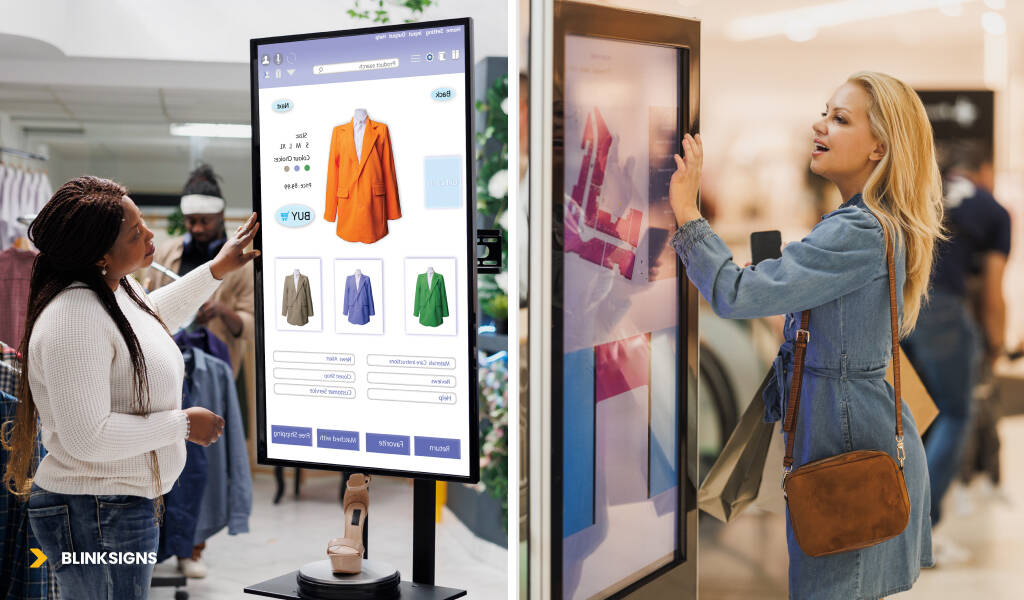
Smart Signage Enhances Customer Experience
When signage responds to customers in real time, the result isn’t just better engagement; it’s elevated trust and loyalty. Here’s how AI-powered displays reshape user interaction across industries:
Personalized Content Delivery
With the help of machine learning algorithms, smart signs can detect audience attributes—such as age, gender, or past behavior—and tailor messages accordingly.
- In retail: A teenage shopper might see trending fashion deals, while an adult sees business wear promos.
- In restaurants: Menu boards adjust based on time of day or local weather—think hot coffee on a cold morning.
- In healthcare: Waiting room screens provide updates or health tips tailored to patient demographics.
The key advantage? Relevance drives response—and AI ensures relevance in every interaction.
Smarter Navigation and Wayfinding
AI signage doesn’t just tell people where to go—it learns how they move and responds accordingly.
- In hospitals or campuses: Wayfinding displays guide foot traffic dynamically, minimizing congestion.
- In transportation hubs: Flight or train info updates in real time, while digital maps adapt to crowds or closures.
- In events or arenas: Directions to booths or entrances adjust based on traffic flow and venue changes.
The result is frictionless movement, reducing frustration and improving overall satisfaction.
Interactive, Engaging Experiences
Smart signs create a two-way interaction that static displays can’t match.
- Gesture-based controls let users interact without touch (ideal for hygiene-focused spaces).
- QR codes can sync content to personal devices instantly.
- Emotional recognition tools adapt content tone—smiling faces might trigger upbeat messaging, for example.
This level of adaptive communication makes customers feel seen, understood, and valued—critical components of modern brand loyalty.
Real-Time Analytics: From Screens to Actionable Insights
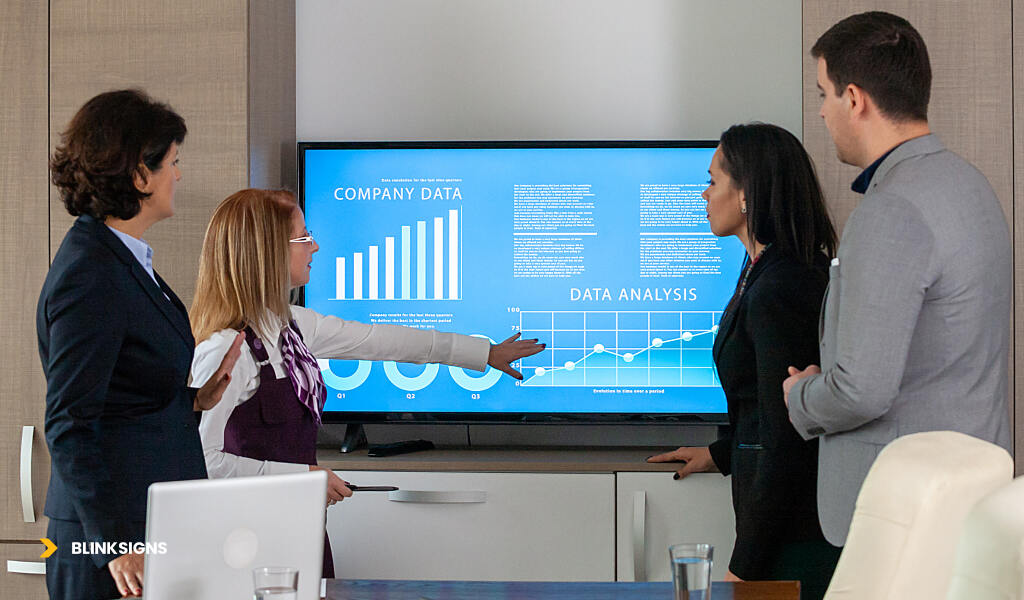
Real-Time Analytics: From Screens to Actionable Insights
AI signage is more than visual communication—it’s a source of real-time intelligence. While traditional signs offer no measurable feedback, data-driven displays track performance automatically, helping you evaluate and adapt in real time.
Using built-in sensors and cloud-based systems, brands can now gather insights like:
- Viewer impressions and dwell time
- Most-viewed content segments
- Heatmaps for on-site display zones
- Foot traffic flow by time of day or week
- Response rates to specific content variations
These insights allow brands to identify which messages resonate, which zones are underutilized, and where to adjust messaging. At BlinkSigns, we integrate this performance feedback into a live dashboard, giving your team the ability to act immediately—whether that means updating pricing, promoting a different product, or redesigning a campaign across all locations.
Smart Signage in Action: Real-World Use Cases by Industry
Smart signage is already solving real problems across industries. Whether you’re a marketing director at a retail chain or an operations manager at a hospital, AI signage introduces agility and control across high-impact areas.
Smart Signage Use Cases and Business Outcomes
| Industry | Use Cases | Business Outcome |
| Retail | Personalized promotions, real-time product ads, loyalty integration | Increased conversion, longer in-store engagement |
| Quick-Service Restaurants (QSRs) | Time-of-day menu switching, upselling suggestions, queue-time displays | Higher average order value, reduced wait frustration |
| Healthcare | Digital wayfinding, multilingual assistance, appointment notifications | Improved patient flow, reduced stress and confusion |
| Hospitality | Lobby directories, digital concierge, event schedules | Smoother guest experience, improved communication |
| Corporate Offices | Interactive building directories, emergency alerts, dynamic branding | Better navigation, centralized communication |
| Educational Campuses | Campus maps, emergency alerts, schedule boards | Increased safety, efficient information delivery |
Each deployment is configured to local needs but powered by a central AI system that ensures your signage evolves with the space it serves.
Responsible Technology: Data Privacy & Compliance
Any system that captures behavioral data must prioritize privacy. BlinkSigns builds every AI signage solution to meet high standards of compliance, transparency, and ethical use.
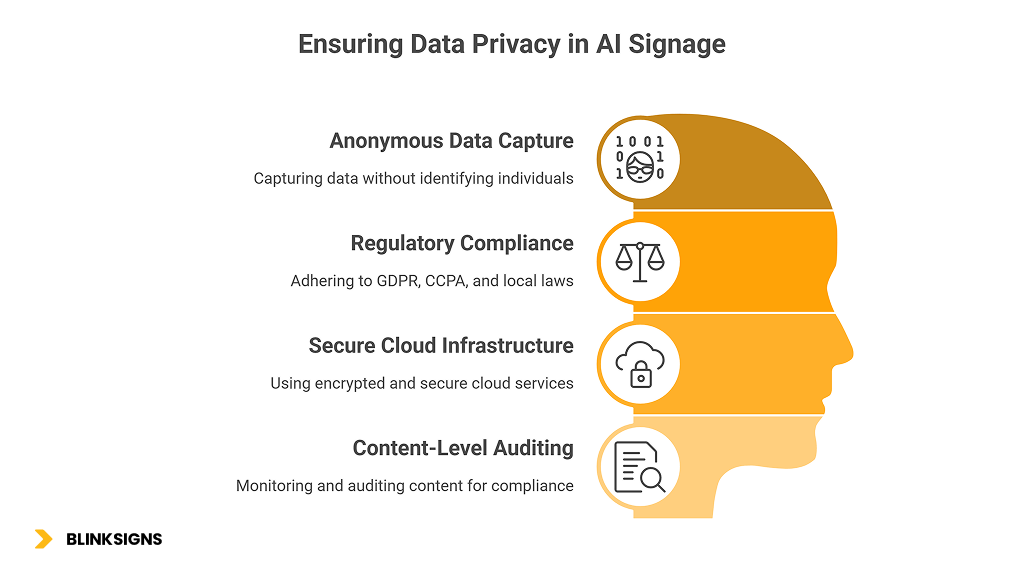
Ensuring data privacy in AI signage- Infographics
We ensure that your signage deployment:
- Operates with anonymous data capture (no facial recognition or storage)
- Adheres to GDPR, CCPA, and local regulations
- Uses secure cloud infrastructure with data encryption
- Enables content-level auditing and opt-out paths where applicable
Data privacy is not an afterthought—it’s engineered into our system architecture from day one.
Why BlinkSigns for AI-Powered Signage
Many businesses want smarter signage, but few have the resources to manage the complexity internally. BlinkSigns provides a full-service approach that makes advanced signage accessible, measurable, and scalable.
We help clients:
- Design signage strategies tailored to their audience flow
- Select displays that support AI, sensors, and cloud CMS
- Implement systems that integrate with CRMs, POS, or internal platforms
- Monitor signage performance and make ongoing content optimizations
- Ensure brand consistency across all digital and physical locations
With BlinkSigns, your signage becomes an intelligent extension of your brand—one that responds, learns, and delivers results.
FAQs: AI & Data-Driven Signage
What size of business can benefit from smart signage?
Both large enterprises and smaller businesses can use scalable smart signage systems. Cloud-based dashboards allow content control across one location—or hundreds.
Can AI signage integrate with my current tech stack?
Yes. BlinkSigns systems can be integrated with POS, CRM, inventory, or traffic tools to enable context-aware messaging.
What kind of analytics can I expect?
Metrics include screen views, engagement time, location heatmaps, A/B test performance, and real-time campaign feedback.
Is AI signage more expensive than traditional signage?
The investment is typically higher up front, but the long-term value—including better targeting, automation, and measurable ROI—often outweighs initial costs.
How long does installation take?
Install time varies by scale, but most full systems—including hardware, CMS, and analytics—can be installed in 2 to 6 weeks.
Conclusion: Smarter Signage, Stronger Connections
AI signage is not a luxury—it’s a response to the way people now interact with physical spaces. Whether you’re guiding, informing, or selling, smart signage helps you connect more meaningfully with your audience.
BlinkSigns delivers intelligent signage solutions built around your goals. With the right tools, your brand can lead—not follow—in delivering high-impact, data-informed customer experiences.